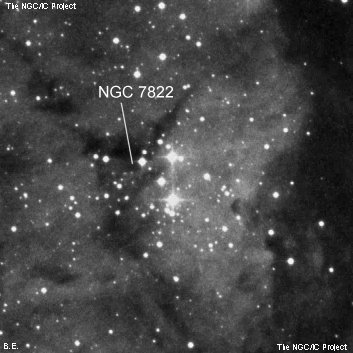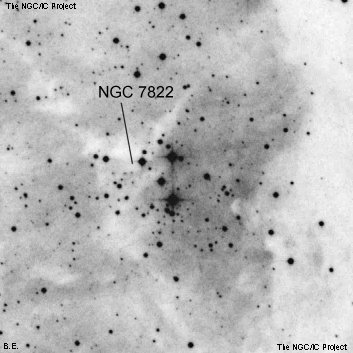NGC/IC Project Restoration Effort
(This is a very very beta version)
NGC7822


Basic Information
Location and Magnitude
Right Ascension: 0:3:36.0
Declination: +67:9:0
Constellation: CEP
Visual Magnitude:
Historic Information
Discoverer: Herschel J.
Year of discovery: 1829
Discovery aperture: 18.3
Observational
Summary description: ! eeF, eeL
Sub-type: EN
Corwin's Notes
=====
NGC 7822. I wonder about JH's declination for this. He has only one
observation of it, and places it quite definitely 1.5 degrees north of the
center of a huge HII region that would match his description pretty well.
Here is what he has to say about it:
The central part of what I am positive is an enormously L, but eF neb of a
round figure, though I cannot trace its limits. The night exquisite. I
swept often across it to be sure, but always recurred to the same place. No
doubt but can never be seen but in the best state of air and sky. Diam
10' +-.
The Herschel Archive is no help -- the left-hand page with the part of the
sweep (223 on 16 November 1829) with the observation is nearly totally blank;
only random pieces of the writing can be seen. The right-hand page does show
the same position that JH published, so there is no transcription error
between the sweep and the published monograph. The sweep was about four
degrees north to south roughly centered on NPD = 22 degrees (for 1830). That
would place JH's object just about in the middle of the sweep's NPD range:
his position is 23 56 01.1, 22 16 20 for 1830. This means that an error of
one degree, or even 1.5 degrees, would still keep the object within the sweep.
Dreyer attached two notes to the object, one in NGC itself: "Not seen at Birr
Castle in two observations. It is, however, far north of the Zenith, and the
speculum may have tilted." In the 2nd IC, he says briefly, "40' diameter,
many stars involved (Roberts, MN lxviii, 301)."
Roberts's description, from three 90-minute plates taken in 1901 and 1902, is
clearly that of the large nebula south of JH's position. Roberts notes three
pretty bright stars involved (BD +66 1675, 1676, and 1679) which make it quite
clear that he thought N7822 to be the HII region. I'm puzzled, though, that
neither he nor Dreyer mentioned the differing declinations. I also find JH's
diameter estimate to be puzzling. Usually, a 10 arcmin diameter would rate a
description of "vL", not "eeL".
Also, there is, centered about 15 arcminutes south of JH's place, a "wing" of
the nebula that could possibly be the object that he saw. But it is fainter
than the main part of the object. Nevertheless, this fainter wing is a
possible candidate for N7822.
However, I'm going to follow Roberts and Dreyer in adopting the HII region as
the object that JH probably described, and assume that his declination
represents an error of some sort. So, it gets the colon, while the northern
wing gets the question mark. I've put the position for the HII region roughly
midway between the latter two BD stars in Roberts's note. I also make the HII
region about a degree across, somewhat larger than Roberts's estimate.
The HII region, by the way, is Cederblad 214B. It is incorrectly listed as a
reflection nebula in at least one catalogue, and various pieces of it have
ended up with separate numbers in Lynds's catalogue of bright nebulae. See
Dixon's "Master List" for a complete list of the various names.
Steve's Notes
=====
NGC 7822
18" (9/15/07): at 73x (31mm Nagler) unfiltered, extends nearly 60' in length (roughly E-W). A group of stars are involved near the middle and includes a nice isosceles triangle of mag 8/8/9 stars with separations of 2.7', 2.7' and 4' with several fainter stars nearby. This group is clearly encased in nebulosity and extends to the east for nearly 30' with quite a few stars involved. Fainter nebulosity also extends to the west in a wide curving lane. The entire glow shows up well at 12.5x in the 80mm finder. Did not experiment with filters.
17.5" (8/25/95): very faint, very large nebulosity best viewed in the 16x80 finder as it gives a higher contrast with the surrounding sky. Appears elongated E-W and at least 40' in size. At 82x, nebulosity is clearly visible in the region of a triangle of mag 8-9 stars including mag 7.9 SAO 20996 at 00 00 57.5 +68 27 27 (2000). A large portion of the field appears weakly nebulous, though not with certainty.
The identification of NGC 7822 is uncertain and may apply to Ced 214 about 1.5 degrees to the south. Here are my descriptions for Ced 214 = Sh 2-171:
18" (9/15/07): at 73x (31mm Nagler) unfiltered, Ced 214 appears as a huge, faint, irregular glow of at least 50' diameter surrounding mag 5.7 HD 225216. Extends as far south as mag 6.3 HD 225136 (28' S of the mag 5.7 star). The NW portion includes open cluster Be 59 (~20' NW of the mag 5.7 star). Generally, the outline can be traced, though it is only vaguely defined in some areas. The east side has a roughly circular outline. Did not compare the view using a UHC or H-beta filter, although despite the previous negative result it was immediately evident without a filter. On deep images, Ced 214 and the elongated section to the north (often taken as NGC 7822) are connected and part of a huge loop extending off the west and east side of Ced 214 and curving to the north.
17.5" (10/4/97): Ced 214 was not detected unfiltered at 82x or using an OIII filter. With an H-Beta filter, a 40' field surrounding the mag 5.7 illuminating star appeared weakly nebulous in contrast to the immediate periphery. No structure noted, although seemed roughly circular. The small open cluster Be 59 is embedded on the NW side. This object may be NGC 7822 if John Herschel made a 1.5 degree error in declination.



